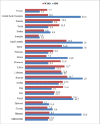The burden of Diabetes, Its Oral Complications and Their Prevention and Management
- PMID: 30159091
- PMCID: PMC6108795
- DOI: 10.3889/oamjms.2018.294
The burden of Diabetes, Its Oral Complications and Their Prevention and Management
Abstract
Background: Diabetes mellitus (DM), chronic disease, is a public health problem that affects 8.5% adult population worldwide. The number of adults with DM has risen sharply from 108 million in 1980 to 422 million in 2014. In 2012, 1.5 million individuals died because of DM and an additional 2.2 million deaths occurred because of high blood glucose level resulting in cardiovascular and other systemic diseases. DM brings huge economic loss to patients, their families, and healthcare systems. Globally, the cost of DM was US$1•31 trillion in 2015.
Aim: This review article utilised the prevalence data of diabetes mellitus from the World Health Organization and International Diabetes Federation to provide a comprehensive picture of the disease in different parts of the world.
Methods: Electronic databases such as Google Scholar, Medline via PubMed, Scopus, and Web of Science were used to search the literature. The library resources of Imam Abdulrahman Bin Faisal University, Dammam, Saudi Arabia were used to retrieve studies on the topics of the present review.
Results: Systemic complications of DM include heart attack, kidney disease, limb loss, blindness, and peripheral nerve damage. More than 90% of diabetic patients were found to have oral manifestations. It is known that DM severely damages oral tissues causing periodontal disease, tooth loss, xerostomia, caries, burning mouth disorder, taste and salivary gland dysfunction, delayed wound healing, lichen planus, geographic tongue, and candidiasis. The evidence is mounting about a strong bidirectional relationship between DM and periodontal disease. Unfortunately, many diabetic patients are unaware of the association between DM and oral health, and only a small percentage of them visit the dentist for routine dental check-ups. Changes in lifestyles (control of blood glucose levels and self-care practices), regular dental check-ups with emphasis on periodontal assessment, and reinforcement of oral health instructions can effectively prevent oral complications of DM. Scaling and root planning are effective in improving glycemic control among diabetic patients.
Conclusion: Dental professionals should be part of the multidisciplinary team that helps individuals with diabetes.
Keywords: Diabetes; Oral complications; Prevention.
Figures





References
-
- American Diabetes Association. Standards of medical care in diabetes—2011. Diabetes care. 2011;34(Supplement 1):S11–S61. https://doi.org/10.2337/dc11-S011 PMid:21193625 PMCid:PMC3006050. - PMC - PubMed
-
- World Health Organization. Global report on diabetes:World Health Organization. 2016
-
- Centers for Disease Control and Prevention. National diabetes statistics report 2017. Atlanta, GA: Centers for Disease Control and Prevention; 2017.
-
- Kim DL, Kim SD, Kim SK, Park S, Song KH. Is an oral glucose tolerance test still valid for diagnosing diabetes mellitus? Diabetes & metabolism journal. 2016;40(2):118–28. https://doi.org/10.4093/dmj.2016.40.2.118 PMid:26616592 PMCid:PMC4853219. - PMC - PubMed
-
- Indurkar MS, Maurya AS, Indurkar S. Oral Manifestations of Diabetes. Clinical Diabetes. 2016;34:54–57. https://doi.org/10.2337/diaclin.34.1.54 PMid:26807010 PMCid:PMC4714722. - PMC - PubMed
Publication types
LinkOut - more resources
Full Text Sources
Other Literature Sources
Medical
